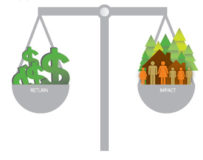
Bron
ThinkAdvisor
As investors increasingly rally behind the concept that their investment choices yield the ability to positively impact social or environmental issues, interest in impact investing has skyrocketed. Of the more than 22,000 investors worldwide surveyed by the Schroders Global Investor Study 2017, 78% claimed that they place more emphasis on sustainability than they did five years prior. Commensurately, 64% indicated that they had increased their allocations to sustainable funds over the last five years — and nowhere was this shift more pronounced that in the U.S.
The impact investment revolution is upon us — and it’s just beginning
Advisors, then, are understandably keen to meet their clients’ growing interest in this rapidly expanding space. The problem? While they might have a high-level understanding of core concepts, many are unwittingly falling short by utilizing key terminology interchangeably. To communicate effectively with clients and gain their trust — which will ultimately attract more assets — it’s important to understand the differences.
Let’s start by taking a closer look at two terms we hear frequently — ESG and impact investing — and how they differ.



